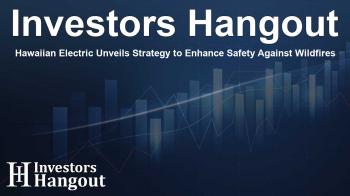Hawaiian Electric Unveils Strategy to Enhance Safety Against Wildfires

Hawaiian Electric's Commitment to Wildfire Safety
In light of recent challenges, Hawaiian Electric has stepped forward with a strategic plan aimed at fortifying the electric grid to minimize the risk of wildfires. This proactive approach comes after intense scrutiny following the catastrophic Maui wildfire incident that claimed over 100 lives and led to extensive damage in Lahaina, estimated at $5 billion.
Understanding the Context of Wildfires
Wildfires have become increasingly linked to power infrastructure across the United States, resulting in severe financial and legal implications for utility providers. Hawaiian Electric is taking significant measures to ensure its equipment does not contribute to future wildfires, recognizing the vital role it plays in the safety of the community.
The Financial Commitment to Safety Initiatives
The utility has outlined a comprehensive wildfire safety plan, projected to cost approximately $450 million between 2025 and 2027. For this year alone, Hawaiian Electric has earmarked $137 million to kickstart these crucial safety enhancements, marking a shift toward a more robust and resilient power grid.
Funding Sources and Support
Some of the financial resources for this initiative have already been secured through existing programs. Notably, the company has received a federal grant aimed at improving grid resiliency, which further supports Hawaiian Electric's commitment to safety and sustainability.
Market Reaction to the Announcement
Following the announcement of the wildfire safety plan, Hawaiian Electric's shares experienced a slight uptick, rising about 1.2% in after-hours trading. Investors appear to be optimistic about the company’s dedication to enhancing safety measures and mitigating risks, which could bolster investor confidence moving forward.
Looking Ahead: The Future of Hawaiian Electric
As Hawaiian Electric embarks on this journey of renewal and safety, stakeholders and the community will remain watchful of the implementation of these plans. The commitment to keeping the power grid safe not only protects the environment but also safeguards lives in the communities served.
Frequently Asked Questions
What is Hawaiian Electric’s new wildfire safety plan?
Hawaiian Electric's wildfire safety plan aims to fortify the power grid to reduce wildfire risks, costing about $450 million from 2025 to 2027.
How did the past wildfires impact Hawaiian Electric?
The company faced scrutiny for its involvement in the deadly 2023 Maui wildfire, which resulted in significant loss of life and property.
What investments are being made this year for safety?
Hawaiian Electric has budgeted $137 million for safety enhancements this year, which is part of its long-term safety strategy.
How is the safety plan funded?
The plan includes funding from a federal grant aimed at grid resiliency along with allocations from existing programs.
What was the market’s reaction to the safety plan announcement?
Following the announcement, shares of Hawaiian Electric increased by about 1.2% in after-market trading, reflecting investor confidence.
About Investors Hangout
Investors Hangout is a leading online stock forum for financial discussion and learning, offering a wide range of free tools and resources. It draws in traders of all levels, who exchange market knowledge, investigate trading tactics, and keep an eye on industry developments in real time. Featuring financial articles, stock message boards, quotes, charts, company profiles, and live news updates. Through cooperative learning and a wealth of informational resources, it helps users from novices creating their first portfolios to experts honing their techniques. Join Investors Hangout today: https://investorshangout.com/
Disclaimer: The content of this article is solely for general informational purposes only; it does not represent legal, financial, or investment advice. Investors Hangout does not offer financial advice; the author is not a licensed financial advisor. Consult a qualified advisor before making any financial or investment decisions based on this article. The author's interpretation of publicly available data shapes the opinions presented here; as a result, they should not be taken as advice to purchase, sell, or hold any securities mentioned or any other investments. The author does not guarantee the accuracy, completeness, or timeliness of any material, providing it "as is." Information and market conditions may change; past performance is not indicative of future outcomes. If any of the material offered here is inaccurate, please contact us for corrections.
